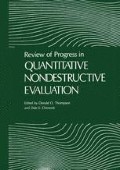Abstract
Ultrasonic means have been used for the nondestructive evaluation (NDE) of a wide variety of mechanical properties in solid materials. Defects such as cracks and inclusions act as sources of wave scattering when illuminated by an incident pulse through reflection, diffraction and mode conversion. Interaction of elastic waves with cracks provides all the needed information relative to inverse characterization of the defects which has not been thoroughly solved yet. Fully understanding these interactions will provide more knowledge for implementing inverse algorithms.
Access this chapter
Tax calculation will be finalised at checkout
Purchases are for personal use only
Preview
Unable to display preview. Download preview PDF.
References
J. A. Cooper, et al, “Surface Acoustical Wave Interaction With Cracks and Slots: A Noncontacting Study Using Lasers”, IEEE Trans, on UFFC, vol. UFFC-33, No. 5, pp. 462, 1986.
C.F. Ying, and R. Truell, “Scattering of a Plane Longitudinal Wave by a Spherical Obstacle in an Isotropically Elastic Solid”, J. Appl. Physics, vol. 27, pp. 1086, 1956.
J. D. Achenbach, et al, “Scattering from Surface-Breaking and Near-Surface Cracks”, Wave Propagation in Homogeneous Media and Ultrasonic Nondestructive Evaluation, 1984.
R. K. Chapman and J. M. Coffey, “A Theoretical Model of Ultrasonic Examination of Smooth Flat Cracks”, Review of Progress in Quantitative NDE, vol. 3A, pp. 151,1984.
L. J. Bond and N. Saffari, “Mode Conversion Ultrasonic Testing”, Research Techniques in Nondestructive Testing. vol. 7, pp. 145, 1984.
L. J. Bond, et al, “Modeling Ultrasonic Waves Using Finite Différence Methods”, Research Techniques in Nondestructive Testing. vol. 7, pp. 135. 1984
K. Harumi, “Computer Simulation of Ultrasonics in a Solid,” Material Evaluation, vol. 44, pp. 1086, 1986.
R. Ludwig and W. Lord, “A Finite Element Formulation for Ultrasonic NDT Modeling”, Review of Progress in Quantitative NDE, vol. 4A, pp. 37, 1985.
R. Ludwig and W. Lord, “Developments in the Finite Element Modeling of Ultrasonic NDT Phenomena”, Review of Progress in Quantitative NDE, vol. 5A, pp. 73, 1986.
Z. You, W. Lord, and R. Ludwig, “Numerical Modeling of Elastic Wave Propagation in Anisotropic Materials”. Review of Progress in Quantitative NDE, vol. 7A, pp. 23, 1988.
Author information
Authors and Affiliations
Editor information
Editors and Affiliations
Rights and permissions
Copyright information
© 1989 Springer Science+Business Media New York
About this chapter
Cite this chapter
You, Z., Lord, W. (1989). Finite Element Study of Elastic Wave Interaction with Cracks. In: Thompson, D.O., Chimenti, D.E. (eds) Review of Progress in Quantitative Nondestructive Evaluation. Springer, Boston, MA. https://doi.org/10.1007/978-1-4613-0817-1_14
Download citation
DOI: https://doi.org/10.1007/978-1-4613-0817-1_14
Publisher Name: Springer, Boston, MA
Print ISBN: 978-1-4612-8097-2
Online ISBN: 978-1-4613-0817-1
eBook Packages: Springer Book Archive

